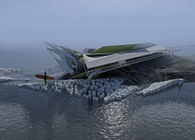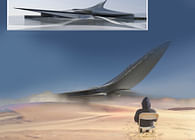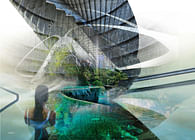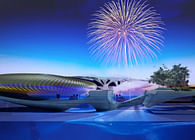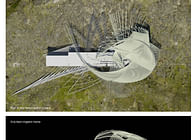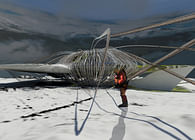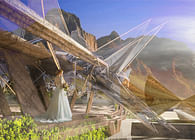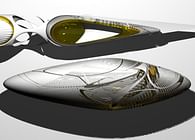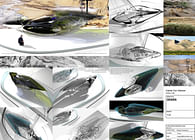
The design brief was originally for an aviary, bird-watching platform, and shelter in the Suzhou Taihu Lakeside National wetland park. The main design objective incorporates the serenity of the environment with the characteristics of birds in flight. The building includes a high tensile steel loom structure that acts as a gallery for the resting birds. The primary structure is made out of a series of stainless-steel spine beams from which motors move and sway like plumes. The structure flutters gently as birds freely fly around the aviary, reverberating like a loom choreographed by birds in flight.
Piezoelectric cells connected to the motor’s fluttering quill-like tentacles harness this movement and produce an electrical current, the piezoelectric cells respond to the overall mechanical stress generated by the structure and use this to accumulate electrical charge, which runs through the dichroic-filtered electrochromic glass cladding in order to modify the façade’s transparency and luminosity. This facade flutter responds directly to the density of bird movement, such that the birds dictate the character of the building within their environment. The structure partly reflects and disappears into the wetlands, creating a superimposed illusion of the surrounding environment by displaying nature as an ever-changing scenery. Surplus electrical energy controls the temperature, humidity, and filtration of the building and takes care of its running costs. Formally, the building dictates its own ecosystem. Its smooth, continuous surface reflects the movement of flocks of birds, contributing to this illusion of an ever-changing horizon line. The dome is an expansive space with no edges, and it gives visitors a perception of an infinite space though the absence of any physical boundaries. Birds are protected from flying into the glass surface cladding with the help of ultrasound signals emanating from the surface. These pulses prevent collision within the projected/simulated limitless horizon as the open building alters spatial awareness. A helical ramp unfolds across the aviary, leading visitors into the wetlands and connecting the entrance of the building to its exterior. The walkway ramp glides along within the building, not touching the building envelope. This self-supporting structure anchors itself into the wetlands, cantilevering as if taking flight. A runway guides the visitors among the birds. This hydraulic ramp can lower and raise, dislocating its form from the overall runway, taking visitors into the height of the building whilst giving them a clear view of the reverberating loom structure. The dome becomes an environmental display screen engaging and disengaging from its immediate context that of the wetlands. The humidity emitted from the building is filtered and ecologically purified to be pumped back into the wetlands via the aviary’s channeled dichroic filtered glass dome. The bird-watching platforms are gently undulating Nforce-fibre terrains that rest on a grid of hydraulic end-bearing piles. Concrete anchors position and enable the pile grid to rise and fall according to the substructure movement whilst maintaining equilibrium within the aviary. The stainless-steel tensile loom structure resonates with movement, gently reverberating. Piezoelectric cells are attached to this loom, generating enough electrical energy for the scheme to be fully self-sufficient.
Status: Competition Entry
Location: China, Suzhou
My Role: Principle Architect

